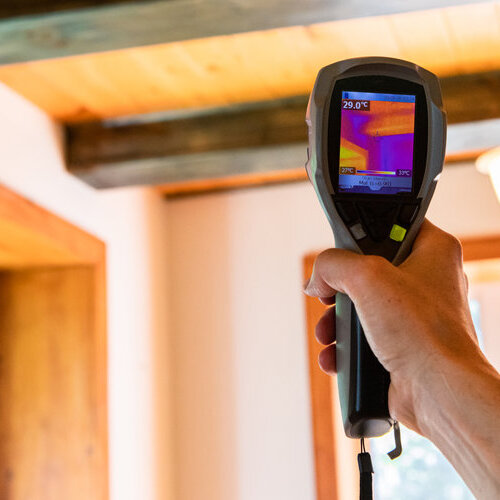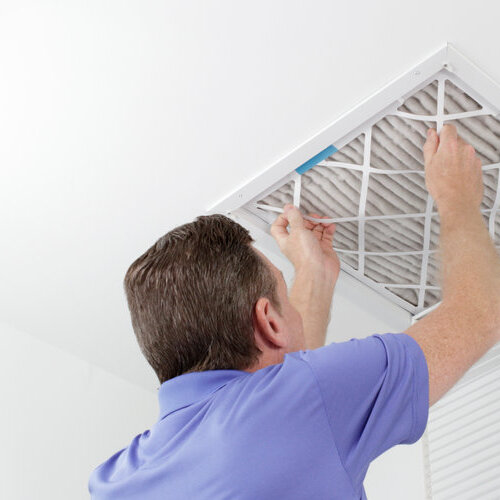
Do I need a home air quality monitor?
When you get home from work, you’re probably thankful to be home where you can breathe easier and safer. Unfortunately, these days our homes aren’t as safe to breathe in as they once were, which is making indoor air quality services a growing need.
Before you deny the air in your home is questionable, ask yourself, “How can I tell if my home air quality is bad? What are the symptoms of bad air quality in your home?” Here are seven indicators your home could use indoor air quality services:
1. Breathing Problems, Coughing
A common poor indoor air quality symptom is breathing problems and consistent coughing. Today, we seal our homes up for energy efficiency, but that creates a lack of ventilation which is a cause of respiratory issues. Without indoor ventilation, the concentration of particles we’re breathing is increased and the fresh oxygen is decreased.
2. Allergies and Sneezing
Along with breathing difficulties and consistent coughing, sneezing is another symptom that is often misdiagnosed and misjudged. Sneezing is usually accompanied by watery eyes and an irritated nose and throat. While this can be from season hay fever and allergies, it can also be from contaminants inside your home. These contaminants can be removed with indoor air quality services to make your allergy symptoms lessen, or even disappear.
3. Dry and Irritated Skin
Does anyone in your home suffer from dry skin, rashes, or redness? If you haven’t been able to pinpoint possible causes, like detergent or bath soap, it could be the indoor air quality. The pollutants in the air become concentrated inside our home then latch onto our skin, blocking nutrients flowing as needed, creating dry skin.
4. Headaches or Nausea
Lingering headaches that can be diagnosed are not normal, so if you’re thinking there is something in the air, you’re right. Even in your own home, there are chemicals and other contaminants that are affecting indoor air quality. These are causing issues with your health causing you to feel dizzy, have nausea, and have frequent or even constant headaches.
5. Sleeping Issues
One thing that indoor air quality services have found with testing is that sleep is severely affected for about 60% of us. That lack of sleep affects other areas of your life too, even impairing your other senses. Setting the thermostat at a cooler temperature helps. It is recommended to keep it between 60 to 68 degrees Fahrenheit, allowing your brain and body to match temperatures.
6. Dust Buildup
Keeping air filters changed every 30 days and keeping your home dusted on a regular basis is the key to better and easier breathing. Experts in indoor air quality services recommend upgrading your air filter to a hyper-allergenic style, having the air ducts cleaned, and keeping your home dusted, all of which will help with breathing issues.
7. Cold and Hot Spots
Are you noticing cold spots along with hot spots inside your home? The air is probably not getting good flow with your HVAC system. Have the system inspected and make sure you are changing the air filter every 30 days or more frequently. Your HVAC technician can also advise you if your system is too small for your home’s square footage, or simply is reaching its prime and should be replaced.
What is an air quality test and what does an air quality test detect?
An indoor air quality test is the only way to find out what you’re breathing in inside your home. Indoor air quality services will measure the air in your home for three different pollutants:
- Biological
- Chemical or VOC (Volatile Organic Compounds)
- Combustion Pollutants
When the results of your indoor quality air tests follow the EPA (Environmental Protection Agency) and OSHA (Occupational Safety and Health Administration) standards. Indoor air quality services focus on things that are health hazards like carbon monoxide, formaldehyde, and radon.
Is there a device that measures home air quality?
Would it surprise you to know that the air quality inside your home is five times more polluted than the air quality outside? A shocking statistic for many, but many outdoor and indoor air quality services have been completed and compared, only to produce the same result. Here are some ways you can do your own indoor air quality testing:
- Indoor air quality monitors: These are available online and at home improvement stores in various price ranges. This device is left on constantly and will measure the IAQ, providing reports on the pollution level inside your home. Each device will vary in what it is testing, but the main things they all test are chemical pollutants, humidity, and particulate matter.
- Mold Testing: Mold is common in most households, and the IAQ device we described above doesn’t report on mold levels. There are inexpensive home mold testing devices available online or t home improvement stores, but indoor quality services experts will tell you they are a waste of money. Mold is everywhere, so the readings will be inaccurate. The best way to test for mold is with a professional service.
- Carbon monoxide alarms: CO (carbon monoxide) is the silent killer. It is colorless, odorless, and tasteless. Exposure to large amounts for a long period is deadly. If your home has any gas-powered appliances, you should have a CO alarm in your home.
- Radon testing: Another colorless, odorless, and tasteless concern. Having a detection device installed in your home is the only way you’ll know your home has radon.
Can phones detect air quality?
Technology! What would we do without it, right? Yes, cell phones can download a free app now that will measure the AQI for your country. It will alert you about air issues and pinpoint major cities with issues. All that without any advertising or in-app purchases while using the app.
What is good indoor air quality?
Approximately 25ppm is recommended by ACGIH (American Conference of Governmental Industrial Hygienists) as a threshold limit for an eight-hour workday. NIOSH (National Institute for Occupational Safety and Health) recommends a 35ppm exposure limit.
In Closing
After reading this piece, you may be asking “Is an air quality test worth it?” And if it found there were issues in your home, you’ll want to know “How do I fix the air quality in my home?” – right? You probably know that we’re supposed to eat three meals a day and drink eight 8-ounce glasses of water each day. Did you know on average, we take 30,000 breaths each day? While we can control what we eat and drink, we don’t always have the ability to control what we’re breathing in 30,000 times a day.
An IAQ test would allow you to know what is in the air you’re breathing. With that information, you can adjust and make changes in your home that will make the IAQ in your home healthier. Here are seven things you can do that will improve the indoor air quality of your home:
- Change the HVAC filter every 30 days or sooner.
- Have the air ducts professionally cleaned every two years or even more frequently.
- Use the vent-a-hood when cooking.
- Keep the carpet and rugs in your home clean.
- Control the humidity in your home.
- Buy indoor plants and place them around in your home for fresh air.

And if you need any other help with indoor air quality services, you can count on our team to be there for you. Just give us a call at 478-781-9107 if you have any questions or if you’re ready to schedule your service.




